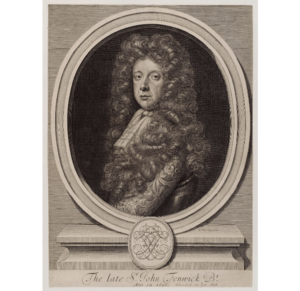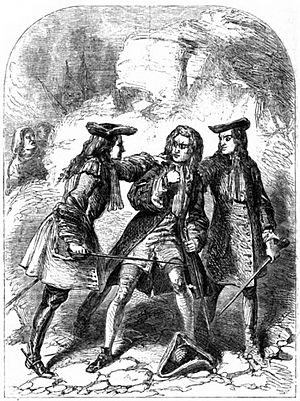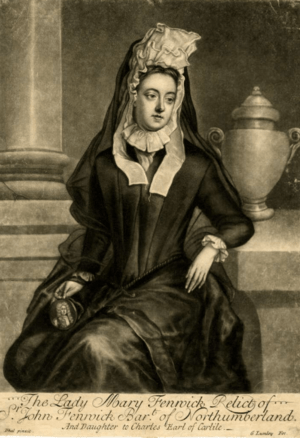Sir John Fenwick, 3rd Baronet facts for kids
Quick facts for kids
Sir John Fenwick, 3rd Baronet
|
|
|---|---|
 |
|
| Born | c1645 |
| Died | 28 January 1697 |
| Nationality | Kingdom of England |
| Occupation | MP and Jacobite conspirator |
| Known for | executed for treason |
| Spouse(s) | Mary Fenwick born |
| Parent(s) | Sir William Fenwick |
Sir John Fenwick, 3rd Baronet (born around 1645 – died January 28, 1697) was an English nobleman. He was known for being involved in a secret plan against the king. He was put to death in 1697.
Contents
Sir John Fenwick's Life
Sir John Fenwick was the oldest son of Sir William Fenwick. His family was very old and came from Northumberland, England. He joined the army and became a major-general in 1688.
Before that, he became a Member of Parliament for Northumberland. He held this position from 1677 to 1687. Sir John was a strong supporter of King James II.
Supporting King James II
In 1685, he helped pass a law against the Duke of Monmouth. This law declared Monmouth guilty without a trial. When William III became king in 1688, Sir John stayed in England. This change of power was called the Glorious Revolution.
Financial Troubles
Sir John had money problems. In 1688, he sold most of his family's land, including Wallington Hall. He sold it to Sir William Blackett for £4,000. He also received £2,000 a year for himself and his wife, Mary. Sir William Blackett became very rich from this deal. He found lead on the land.
Plotting Against the King
Sir John Fenwick began to plan against the new King William. Because of this, he was put in prison for a short time in 1689. After he was released, he continued his secret plans. In 1691, he even insulted Queen Mary in public.
It is almost certain he was involved in plans to harm King William. These plans became known in 1695 and 1696. After some of his friends were caught, Sir John went into hiding. However, his friends tried to make a witness against him leave the country. This led to Sir John's arrest in June 1696.
The Act of Attainder
To save himself, Sir John offered to tell everything he knew. He claimed to know about other secret plans. But his confession was not helpful. He only accused some important noblemen.
At this time, his friends had managed to make one of the two witnesses disappear. This usually meant the charge of treason would fail. However, the government found a way around this. They introduced a special law called a bill of attainder.
After many long discussions, this law passed through Parliament. It declared Sir John Fenwick guilty of high treason. This meant he was guilty of trying to harm the king. His wife, Mary, tried very hard to save him. But her efforts did not work.
Sir John Fenwick was put to death in London on January 28, 1697. This was done with the same traditions as when a nobleman was executed. He was the last person in England to be put to death under an Act of Attainder.
Family and Legacy
Sir John and his wife, Mary (who died in 1708), had three sons and one daughter. All of their children died young. They are buried with Sir John in St Martin-in-the-Fields.
A famous historian, Macaulay, wrote about Sir John. He said that King William truly disliked Sir John. It is believed that Sir John's hatred for the king started when William, then Prince of Orange, scolded him while he was serving in Holland.
A horse owned by Sir John, named White Sorrel, was taken by the Crown after his death. King William later fell from this horse, which stumbled on a molehill. This fall partly led to King William's death. Because of this, people who supported King James II would secretly toast to 'The little Gentleman in Black Velvet.' This was a secret way to honor the mole that caused the king's fall.
Sir John Fenwick is also remembered in a folk song called Sir John Fenwick's The Flower Among Them All. His wife had a memorial built for him in York Cathedral. She was buried there after she died in 1708.



